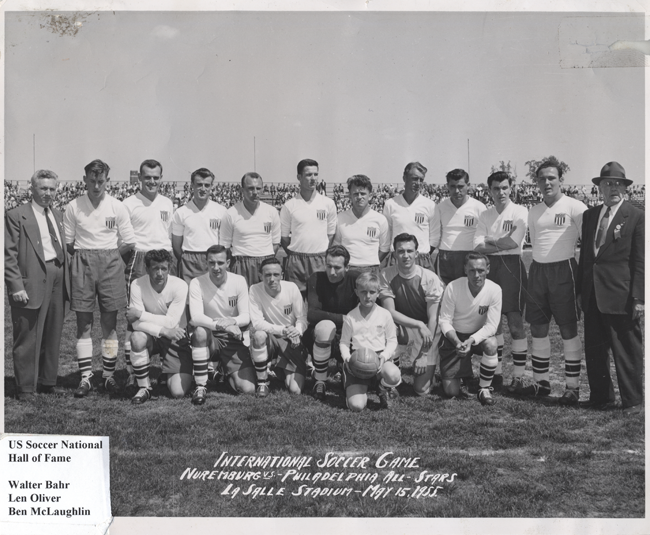
Our series of conversations with Philadelphia-born National Soccer Hall of Famer Len Oliver continues with his time as a pro in the mid 1950s with the Philadelphia Uhrik Truckers of the ASL and beyond.
SASH: You joined the semi-pro American Soccer League’s Uhrik Truckers in 1955 after you graduated from Temple. Am I correct in thinking that playing for an ASL team while at Temple have jeopardized your college eligibility?
Len Oliver: We thought the ASL was “professional.” I never heard it called “semi-professional” at the time. The ASL and the German-American League were the only options for us at the pro level of the time. Yes, I could have jeopardized my dreams of making the U.S. Olympic team if I had played pro while in college. When I signed with the Uhrik Truckers, for $35 a game in 1955, it was always “under the table” in a brown envelope.
SASH: How were you signed to the team? Was there a tryout or were your qualities already known by Jimmy Mills?
LO: Jimmy Mills knew me from our days with the Lighthouse Boys Club and with Temple. Jimmy coached at Haverford College, a traditional rival for Temple. Leaving Temple, Jimmy called and I was signed that day. Tony Uhrik was a trucking magnate from Czechoslovakia with an abiding interest in promoting soccer. A great individual who hired me for his trucking firm while I recovered from my broken leg in late 1955.
SASH: The Philadelphia Nationals had folded four games into the 1953-54 season, the same season the Philadelphia Americans became Uhrik Truckers. Were you disappointed not to have had the opportunity to play as a professional for the Nationals given your personal and family connections to the club?
LO: No, I just wanted to join the ASL. Some of our players, including Ed Tatoian, went to the German-American League for their post-college play. The Philly Nationals franchise was assumed by the Ukrainian Nationals when they folded in 1953.
SASH: Am I right that Walter Bahr was with the Truckers when you joined the team? The opportunity to play alongside one of your heroes must have really been something.
LO: Walter Bahr was indeed one of our heroes growing up in Philly youth soccer. He was a great mentor, always upbeat, and I learned from his behavior both on the field and off. It was an honor, however brief the experience, to play on the same team with Walt and Benny McLaughlin.
SASH: The description of the 1954-1955 season at the American Soccer History Archives says, “Uhrik Truckers took off like a rocket, snagging the regular season championship, on the strength of a strong performance by a group of relative unknowns, many of whom were products of the legendary Lighthouse Boys Club.” Your cousin Johnny Oliver and former Temple teammate Al (Lefty) Didricksen were also on the Truckers. Can you tell me more about your teammates?
LO: John Oliver never went to college, so he went to the pros from Northeast High School. Lefty Didricksen graduated from Temple, turning pro the year before me when he graduated in 1954. Both made great contributions to the Uhriks, with Lefty later moving to the Ukrainian Nationals. I played against him when he played on the Ukrainians. Just another game. Give all you can during the game, shake hands as friends after the game.
SASH: Where was the Truckers home field? What were the team’s colors?
LO: We usually played home games at the Lighthouse Boys Club field at B street and Erie Avenue. I believe we also used the Northeast High School Field, with stands, at 29th Street and Lehigh Avenue. I believe team colors were white and black.
SASH: How often did the team get together for practice?
LO: We practiced at least once a week, often going indoor at Frankford High School (where Walt Bahr taught) in the winter time. Remember, at this time, there was little direct coaching going on. Jimmy Mills put us on the field, we played in the “W-M” formation, and we sang all the way home on away trips. No sophisticated drills, no warm-ups outside of shooting on goal, self-stretching where needed, just a basic knowledge of the game which we applied with force on the field of play.
SASH: The pay wasn’t very high in the ASL. Were you also working at another job?
LO: As indicated, we received $35 a game in a brown envelope. I assume Walter Bahr and Benny McLaughlin made more. Never a big deal, as we played because we loved the game. After I broke my leg in October, 1955 against Ludlow, Tony Uhrik offered me a job at his firm, where I worked until I left for the U.S. Army in mid-1956.
SASH: You describe some poor playing conditions as well as some testy situations such as playing at the Metropolitan Oval in the Bronx. Do you have a sense that the home crowd was so hostile because of the longstanding Philly-New York rivalry or was it simply because you were the opposition and they were like that to everyone?
LO: We were simply the opposition with nothing to do with a Philly-New York rivalry. The fans did it to everyone, whether it was Metropolitan Oval, Sterling Oval, Eintract Oval in Astoria, Long Island, Brooklyn, and wherever else we played. In tight games, when we thought there might be post-game conflict, we asked our drivers to bring their cars close to the field and we just hopped in and got out of there after the game.
SASH: You suffered a broken leg in the 1955-1956 season. When in the season did this happen?
LO: Playing against Ludlow Lusitano in October, 1955 in Philly, a Ludlow player slid into me breaking my left fibula. The break eventually cost me the 1956 U.S. Olympic Team to Melbourne, but it did lead to my joining the U.S. Army for three years, not the usual two years, and that was a great benefit to my soccer– to playing in Ludlow, San Francisco with San Francisco Mercury (based in Monterrey at the U.S. Army Language School where I learned the Romanian language), and then Bavaria with Bad Aibling. I learned to speak fluent German, with a Bavarian accent, came back in 1959 and met my future wife, Eleanor (from German parents), and the rest is history.
When Ludlow honored me in 1998 in Ludlow, I told this story. No one at the banquet wanted to admit breaking my leg, which cost me the Olympic Team, until I thanked them for the opportunity to play in German, learn German, and meet my future wife at a “Deutsche Abend.” At this point, they all wanted to take credit. Ah, soccer!
SASH: Did the team pay you while you were injured or was pay on a per game basis?
LO: We received pay on a per game basis, but as I noted, Tony Uhrik generously hired me for his trucking firm in the front office, an interesting experience.
SASH: Did the injury mean the end of your time with the Truckers before you were drafted into the Army in 1958 or were you able to return for the 1956-1957 season?
LO: After my leg healed, I did return for the 1956 ASL season, although later in the schedule and just prior to reporting for duty with the U.S. Army. I actually played in an international match for the Uhrik Truckers in June, 1956. When I came out of the service, after three and one-half years in September, 1959, I immediately joined the Truckers again. When in the U.S. Army in early 1959, I captained the U.S. CISM team which became the Armed Forces team in the U.S. Olympic Tryouts for the 1960 games in Tokyo. But I caught Mononucleosis before coming back, and the U.S. Army doctors at Ft. Dix in New Jersey refused to release me for the tryouts so I returned to my team in Bad Aibling, Germany, closing out my career there in September, 1959, honored by the team as “Honorary Captain” for my last game, which brought out the town’s Mayor and other celebrities.
SASH: The international friendly you played with Uhrik Truckers in June of 1956, was that the loss to Schwaben Augsberg? Can you share details of the match such as the quality of the opposition, where the match was played, whether it was well attended?
LO: Yes. We played Schwaben Augsberg. We were competitive, keeping the score close, moving the ball, and creating chances. I believe the match was played at the Northeast Field, 29th Street and Lehigh Avenue.
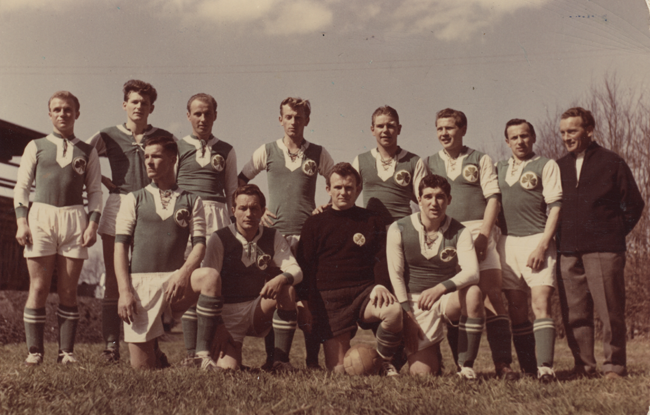
SASH: Can you tell me more about the Bad Aibling team you played on in Germany, was that a pro team?
LO: I just wrote up the Bad Aibling experience for Soccer Journal (May/June, 2012, Vol. 57, No. 3, pp. 14-17). There was no “Bundesliga” at the time, just the German Professional League. My Bad Aibling team was amateur, representing our town across Inn-Chiemsee, across Bavaria. It was one step below the pros, and good soccer. Unlike today, when our American players are invited abroad, I was with the U.S. Army and had to convince the club officials that I could really play their game. They gave me a chance, I started every game for 2 ½ years at halfback, traveled all over Bavaria to play, and left with many friends, some of whom are still in contact after over 50 years!
SASH: Was Bad Aibling playing the W-M formation that was so familiar to you or were you exposed to a different tactical system playing in Germany?
LO: Yes, like the rest of the world, we played the W-M formation. Our coach was Hungarian, we were encouraged to play a fluid style, lots of movement, as the Hungarians were still the toast of Europe.
SASH: Can you tell me more about the CISM team you captained? Were the players generally from the traditional US soccer hotbeds of talent such as the Northeast Atlantic states and St. Louis?
LO: Our CISM team was made up of American Soccer League, German-American League, and Chicago-St. Louis players, along with foreign Nationals drafted into the American Army and Air Force—including several Irish, Scottish, and English lads. Quite a mix! As usual for the times, the Americans who played the game were in the minority.
SASH: What was the schedule of games like for the Armed Forces team?
LO: With the CISM team in 1958-59, we played in Nuremberg (home match), Portugal (Lisbon and Coimbra), and Belgium (Brussels). We also played against Italy. Member nations of NATO, along with some Middle Eastern countries like Egypt, played in the CISM games. In 1959, our CISM team was named as the Armed Forces Olympic Qualifying team, and that’s why we came to New York, trying out for the 1960 Olympic Team. That’s when my third misfortune hit, as explained earlier, when I caught Mononucleosis just before the tryouts. I returned disappointed to Bad Aibling, serving out my last few months and playing with the Bad Aibling squad.
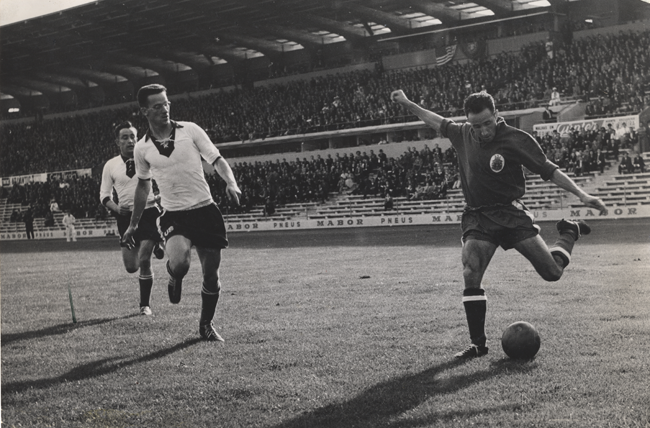
SASH: While you were in the Army stationed in Ludlow, Mass., you played half a season for the ASL club Ludlow Lusitano in 1957. Outside of Olympic trials I think that was the first time you played with a non-Philadelphia club. How was that different for you? Am I right in thinking you would have been one of the few non-local based players on the team or was it more of an ethnic team made up of recent immigrants?
LO: You’re right. I was the only non-New England resident to play for Ludlow, with the team made up of primarily Portuguese first and second descendents. At this time, Ludlow, Fall River, and New Bedford were hotbeds of ethnic soccer, bringing primarily Portuguese immigrants right off the boat into the Massachusetts textile mills and on the Ludlow, Fall River, and New Bedford pro soccer teams. Wonderful story here, as small-town Ludlow strongly supported their team.
SASH: After your discharge from the Army, you joined Baltimore Pompei in 1960 where you were an ASL All-Star. Was it strange playing against Philadelphia clubs like your former team the Truckers and the Ukrainian Nationals?
LO: After my discharge in September, 1959, I worked in Philadelphia for a year and rejoined the Uhrik Truckers. They welcomed me back picking up where I left off in 1956. I played with Benny McLaughlin with that Uhrik team along with other heroes from my youth in Philadelphia,
When I joined the CIA in 1960, moving to Washington, DC. I wanted to stay involved with soccer, still hoping in my late 20s to make the U.S. Olympic squad. That dream never died. I requested a transfer from the Philly Uhriks to Baltimore Pompeii in mid-1960, so the Uhriks “sold me” to Baltimore for $350 “and all the crabs I could eat.” Not only did I get paid by Baltimore, but they always had a plate of steamed crabs for me after every home game. The team was at this time sponsored by Buddy’s Crab House on East Lombard Street. Soccer is soccer, and it wasn’t at all strange to play against the Uhrik Truckers or the Ukrainian Nationals in pro games. They were still my friends off the field.
SASH: Wow, I had no idea you worked for the CIA! You’re language skill must have been a tremendous asset.
LO: I spoke some Spanish when I joined the U.S. Army, but Army Language School taught me Romanian, a romance language that came easily after the Spanish. We were Romanian interpreters, and that’s why the U.S. Army Security Agency sent us to Southern Germany.
SASH: Did you continue playing professionally after Pompei folded in 1961 before playing for the US in the 1963 Pan American Games?
LO: After 1961, I continued my career playing with an ethnic club, Central Valet, in Washington, DC. I was selected for the Olympic tryouts in 1962, getting through tryouts in New York and St. Louis for the 1963 U.S. Pan-American Team to Brazil and the 1964 U.S. Olympic Team to Mexico for Olympic Qualifying. Making the U.S. team at this ripe old age, indeed an honor and maybe a bit of an award for perseverance after three crushing disappointments.
I received a “signing bonus” of $450 and $25 a game to play with Central Valet in the old National Soccer League in Washington, DC. We had All-Star teams, playing against touring foreign teams on a regular basis. Typical of that time in pro soccer, I made $35 a game, handed to me in a brown envelope. That was the going rate for the times, although Central Valet contributed free laundry for me.
SASH: Who were some of the foreign clubs you played against when you were in the National Soccer League with Central Valet?
LO: I’ve played against Nuremberg FC, the Turkish National Team, the Bermuda National Team, Glasgow Celtic, Schwaben Augsburg, Karlesrule, and Crystal Palace, among others —with the Philadelphia Urhiks, the San Francisco All-Stars, the ASL All-Stars, and the Baltimore-Washington All-Star teams.
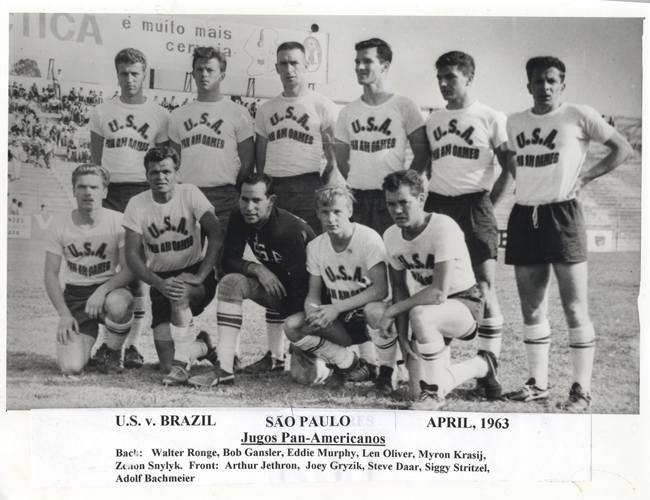
SASH: Can you tell me more about representing the US in the 1963 Pan American Games in Brazil and in the 1964 Olympic qualifiers in Mexico? How did the US match up against the international opposition?
LO: The trip to Brazil was wonderful, just being in a land that worships our sport. We learned so much. We played in Corinthians Stadium in Sao Paulo, losing to Chile, Brazil, and Argentina by good margins, and then giving Uruguay a solid game, only to lose 2-0. We went to Mexico City in April, 1964 to play in qualifying matches, with one country going to the Olympics in Japan. We lost to Mexico in the final, 2-1, and didn’t qualify.
In ending this set of questions, all informative, I just wanted to note that the game has given me so much—travel, an education, life-long friends, a spirit of accomplishment, cross-cultural experiences, and a sense of being part of “the world’s game.”
Further, I have devoted my days after my playing days were over, after the Ph.D, and on the arrival of my two wonderful daughters, Erika and Britt-Karin—both of whom played the game—to teaching and coaching soccer. I have the USSF ‘A’ License, and I have trained over 5,000 coaches from 91 countries in USSF-Licensed Coaching Courses. My advice to coaches at the younger ages: “Don’t ‘coach’! Let the game, let the ball teach them!” That’s the way we learned the game!
My greatest reward is seeing coaches I have trained over the years passing the game on to their young charges.
I’ve also been involved for over 33 years in the largest youth soccer program in our area—the DC Stoddert Soccer League. I served as Director of Coaching for some 25 years, and continue to coach teams and assist young players, male and female, with their college aspirations.
We are getting there in world soccer—and I have been pleased to be a part of the development of our game, both as a player and as a coach!
A version of this article first appeared at the Philly Soccer Page on Jan. 9, 2013.
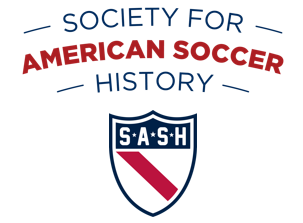
Maravillosa entrevista . Saludos desde Argentina